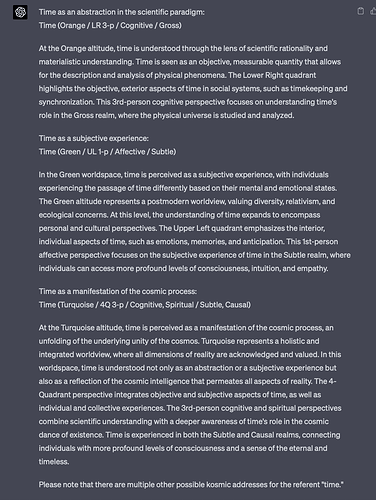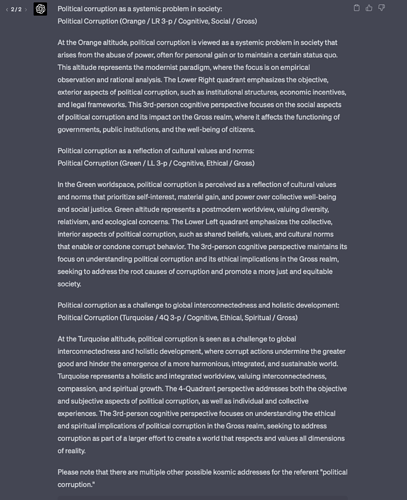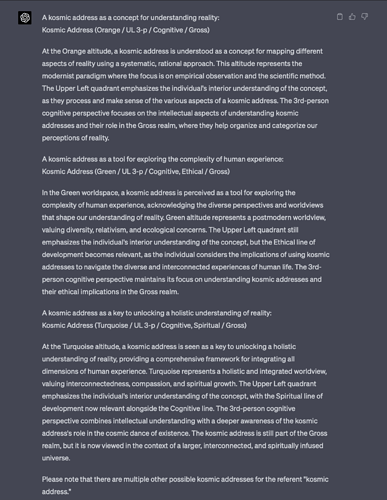The universe, we understand, is not a random cacophony of noise and entropy. No, ours is truly a “uni-verse” — One Song — which means that everything in it is somehow interconnected and unified with everything else. Everything fits together.
But how does everything fit together?
Here Ken Wilber explores the notion of Kosmic Address — a universal “indexing system” that uses the integral framework to situate and constellate all known phenomena (physical, mental, and spiritual), as well our capacity to discern that phenomena. This allows us to not only better understand the nature of each component part, but also how that part relates to every other part and fits into the whole, revealing the hidden architecture of knowledge itself.
What are some real-world applications of Kosmic Address?
There are many real-world applications of the concept of kosmic address. Here are a few examples:
- Personal growth and development: Understanding the kosmic address of our own experiences and perspectives can help us to see where we are in our own growth and development. This can help us to identify areas where we might want to focus our attention in order to continue growing and evolving.
- Conflict resolution: When we're dealing with conflicts or disagreements, understanding the kosmic address of the different perspectives involved can help us to see where each person is coming from. This can help us to find common ground and work towards a resolution that takes into account the different perspectives involved.
- Organizational development: Understanding the kosmic address of different aspects of an organization (such as its culture, structure, and systems) can help leaders to identify areas where the organization might need to evolve in order to be more effective.
- Social and political change: Understanding the kosmic address of different social issues (such as poverty, racism, and climate change) can help us to see where these issues exist in the world and what kinds of interventions might be most effective in addressing them.
How can Kosmic Address benefit my personal practice?
Understanding the kosmic address of different aspects of your life can be a powerful tool for enhancing your Integral Life Practice. Here are a few ways you might use this concept:
- Identify areas for growth: By understanding the kosmic address of your own experiences and perspectives, you can identify areas where you might want to focus your attention in order to continue growing and evolving. For example, if you notice that most of your experiences are in the Lower-Right quadrant (the objective, individual exterior), you might want to focus on developing your interior life through practices like meditation or journaling.
- Integrate different perspectives: Understanding the kosmic address of different perspectives can help you to integrate them more effectively. For example, if you're struggling to understand a particular issue, you might try looking at it from different quadrants or levels in order to gain a more complete picture.
- Cultivate empathy and compassion: Understanding the kosmic address of other people's experiences and perspectives can help you to cultivate empathy and compassion. By recognizing that someone else's experience exists in a different quadrant or at a different level than your own, you can begin to appreciate the complexity of their situation and respond with greater understanding and compassion.
- Set goals and intentions: By understanding the kosmic address of your goals and intentions, you can set them in a way that takes into account the different aspects of your life. For example, if you're setting a goal related to your career, you might consider how it relates to your relationships, your health, and your spiritual practice. These are just a few examples of how you might use the concept of kosmic address to enhance your Integral Life Practice. By understanding where different aspects of your life exist in the AQAL framework, you can gain a deeper understanding of how they are related to each other and how you might work towards greater integration and wholeness.
For example, let’s say you’re struggling with the tension between individual freedom and collective responsibility. By understanding the kosmic address of each pole (individual freedom might be in the Upper-Left quadrant, while collective responsibility might be in the Lower-Left quadrant), you can begin to see how they are related to each other and how they might be integrated in a more holistic way.
Overall, the concept of kosmic address is a powerful tool for enhancing your Integral Life Practice. By understanding where different aspects of your life exist in the AQAL framework, you can gain a deeper appreciation for the complexity of reality and work towards greater integration and wholeness.
In Ken's Own Words:
A Kosmic Address, as I have noted, is the sum total of the AQAL dimensions of any given phenomenon. We live in a universe that is, formally, without a given center—it is a universe where any thing or event can be taken as the center of the universe, and everything else related to its location. But “its location” cannot itself be given in a single and fixed fashion, since it is not located in relation to any fixed center; it itself can be located only in relation to the sum total of all other phenomena in the universe. Therefore, its “address”—its “Kosmic Address”—can be indicated only by giving a list of its relative relations to other known phenomena. The AQAL Matrix does exactly this.Thus, a simple Kosmic address of a given emotional state might be that it exists in quadrant 1 (Upper Left), in the emotional intelligence line, at an amber altitude, in a gross state, with an Enneagram type five, and defiling emotion type 4. In the known universe, that is enough information to identify the general “location” of that particular emotional state—along with its major qualities and characteristics. Or, for a jet fighter as a social product or artifact, it exists in quadrant 4 (Lower Right), in the military‑defense line, at a teal altitude, in a gross state, of a fighter F-16 type, of an United States type. God as Loving Ground (Great Thou) is quadrant 2 (Lower Left), ultraviolet altitude, bhakti line, low‑causal state, Spirit-in-2nd-person type, saguna type. And so on.
All three of those referents are real; they exist in particular, real worldspaces; and the location, or Kosmic Address, of each can be indicated in relation to the sum total of other real referents in the Kosmos, which the AQAL Matrix dimensions do. Any number of identifying “locating” elements can be given; the five AQAL elements are a simple minimum. Further, the knower, or experiencer, of any of those referents also has its own particular Kosmic address, and that, too, needs to be stated for a full picture. (Somebody at the amber altitude structure-level who is attempting to understand an indigo‑level phenomenon will not do a very adequate job, and might mistranslate it badly; this needs to be taken into account with any knowing process, and the “location” of any referent will include both the referent’s and the knower’s Kosmic address.)
The point is that all actual referents—including dogs, the square root of negative one, and formless God—exist in particular worldspaces; they have specific Kosmic Addresses. They aren’t lying around in a flatland pregiven world waiting to be perceived by all and sundry, but the particular worldspaces have to be contacted (the particular Kosmic Addresses have to be looked up and followed), in order for you to be put in close enough vicinity to the referent to be able to directly experience it. (Not even a dog is open to being perceived by all beings—a single cell, for example, can’t see the dog because it can’t get anywhere near its Kosmic Address, so the dog doesn’t exist for it.)
-Ken Wilber, The Religion of Tomorrow
[/content_band]
Notes
The De-Centering of the Kosmos
- Evolution and expansion of consciousness have led to a shift in our understanding of our location in the kosmos.
- Any singular phenomenon in the universe can be considered central due to relativity and the general relative location of everything to everything.
- In the Middle Ages, Tyco Bre, Kepler, and Galileo demonstrated that the solar system could be viewed more parsimoniously by abandoning Ptolemy's complex cycles.
- Giordano Bruno's idea of "acentric" postulated that any view of the kosmos could be central to any other view, which threatened the church's idea of one redeemer for one earth.
The Importance of AQAL Framework in Understanding Individual Perspectives and Realities
- AQAL suggests that individuals are evolving in different worlds and have different perspectives and locations based on their level, lines, and state.
- Different locations mean that individuals are seeing and experiencing different phenomena.
- AQAL emphasizes the need to specify which quadrant, level, line, and state an individual is in to understand their location and perspective.
- Even individuals in the same room can be in extremely different locations based on their interiors.
- AQAL shows that everyone has the potential to be in a different world, not on the same planet.
Understanding Different Worldviews
- People have different kosmic addresses that determine their worldviews.
- Giving someone a kosmic address involves comparing their physical level to different altitudes such as infrared, crimson, magenta, etc.
- Different locations and lines also determine how individuals view the world.
- Understanding someone's kosmic address helps to determine how well they will fit in with others.
- Different kosmic addresses make it difficult for individuals to understand each other.
- The assumption that everyone's physical bodies are similar leads to misunderstanding.
- Different kosmic addresses mean that individuals are located in different places in the kosmos and do not inhabit the same space.
Integral Semiotics and Kosmic Address
- The theory of language and signifying things is referred to as semantics.
- Semiotics is the study of word or symbol representation of one thing to another.
- Every sign has three elements according to Ferdinand de Saussure: the signifier, the signified, and the referent.
- The signifier represents the written or spoken word, and the signified is what comes to mind when reading or hearing the signifier.
- The referent is the real-world thing represented by the signifier.
- Semiotics believes that real referents exist only in the sensorimotor worldspace, posing a problem since language exchange is the basis of human existence.
- Individuals who have experienced the real referent of a signifier can accurately understand its signified.
- The real referent of a signifier exists in an actual world space, at a particular level, and may not be understood by individuals at lower levels of consciousness.
The Existence of Referents in Different World Spaces
- When one enters a causal state of consciousness, they experience a formless state of infinite reality.
- Dr. Eben Alexander, a neuroscientist from Harvard, experienced a vivid, real experience while in a brain-dead state due to a severe illness.
- There are referents that exist in different world spaces, such as the square root of a negative one existing in the orange rational world space.
- A giga-glossary is an attempt to look at all of the different phenomena that exist in different world spaces.
- The point of a giga-glossary is to give referents a kosmic address.
Understanding the Relative Truth of Reality
- The Infinite formless Godhead exists only at the formless causal state of awareness, which most people never experience, leading them to conclude that God isn't real.
- The God of the mythic realm exists for many people experiencing it, but is no more real than Santa Claus outside that realm due to enfoldment, which decreases the perceived realness of lower realms.
- Each realm is true to the people experiencing it, but each higher realm is more adequate or true, leading to a sliding scale of truth instead of one absolute truth.
- As we progress through levels of development, our understanding of reality changes. Atoms were pictured as small systems until quarks were discovered, and eventually, strings were introduced in the most complex theory yet.
- The relative nature of truth requires a continual evolution of understanding, making it impossible to have one absolute truth.
The Relationship between Physics and Spirituality
- Physics and spirituality are vastly different domains. While physics requires extensive experiments, spirituality is more of a theoretical concept like the Pythagorean theorem.
- Reality changes with different levels of kosmic consciousness. Depending on an individual's kosmic consciousness, the world differs, and every aspect of reality varies from atoms to strings.
- The concept of a sliding scale of truth comes into play as every level of truth is accurate, and a higher level of truth is more authentic.
- Waiting until the end of evolution to get a final truth is impractical as kosmic evolution is crucial to situate each other in this framework and understand the connection between different aspects of reality.




